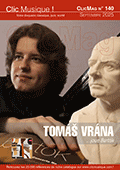 Deux œuvres du compositeur hongrois Karl Goldmark : la très célèbre (et souvent enregistrée) Symphonie dite « rustique » et une ouverture inédite assez ambitieuse. L'op. 38 "Der Gefesselte Prometheus" condense les qualités et les petits défauts qu'un critique de l'époque imputait au style de Goldmark : invention mélodique jaillissante mais souffle court, forme fragmentée. Trop moderne pour l'époque, la partition, d'une structure hachée et peu limpide, convoque judicieusement toutes les ressources de l'orchestre. Dès les premières mesures, la tension monte en un long crescendo puis s'affaisse soudainement pour rebondir de façon récurrente, enchaînant des thèmes puissants, ce, jusqu'au final pétaradant. Musique d'une efficacité narrative remarquable dans sa description chaotique du personnage du Prométhée enchainé. La symphonie "Ländliche Hochzeit" op. 26 (Un mariage de campagne) doit autant à Beethoven (La Pastorale) qu'à Hector Berlioz (le potentiel orchestral). Cinq mouvements d'inspiration fraiche et bigarrée. Une piquante marche mariale ouvre la cérémonie, ensuite la traditionnelle chanson du jeune marié (Brautlied), une émouvante sérénade en forme de scherzo, le bucolique "Im Garten" évoque la scène d'amour du Roméo de Berlioz, enfin, une danse folklorique menée à grand train. L'interprétation du RSP dirigé par Frank Beerman, collaborateur régulier du label CPO, restitue avec élégance et précision (l'équilibre des pupitres) le fourmillement des détails orchestraux de ces deux "poèmes symphoniques", et parvient à traduire la bipolarité de cette musique, à la fois légère et rustique mais aussi volontiers sophistiquée. (Jérôme Angouillant)  Karl Goldmark numbers among those composers whose former fame and glory later regrettably faded. Nevertheless, Goldmark enjoyed a highly successful career – from the son of a poor Jewish cantor in the Hungarian countryside, initially without school instruction, to a professor of composition and composer in Vienna. Today this Hungarian composer continues to be known to a broader pubic only for his violin concerto and the opera The Queen of Sheba (soon to be released on cpo). During his lifetime he was celebrated for his instrumentation artistry, refined use of elements from folk music, and highly developed talent for melodic invention. At the time Goldmark’s most famous orchestral work was his Hochzeitssymphonie (Wedding Symphony), which celebrated a premiere triumph. His friend Johannes Brahms said that this work, perfect in form and flawless, had sprung into life like Minerva from Jupiter’s head. Sir Thomas Beecham and Leonard Bernstein were very fond of this highly effective work and frequently conducted it. Goldmark’s Overture to the Prometheus Bound of Aeschylus also met with an enthusiastic response. For example, on 28 March 1890 Eduard Hanslick wrote as follows in the feuilleton of the Neue Freie Presse: »The overture, one of Goldmark’s best, maturest compositions, is appealing not merely because of its ardent energy of expression; it also has musical content and a clearly structured form. Something really happens in it, in a musical sense, not in the misunderstood sense of a dramatic imitation. The overture begins like the solemn calm of the sea with an Adagio in C minor; the same gradually presses for more vehement motion, which fully streams in the Allegro movement (likewise in C minor)".
 |
